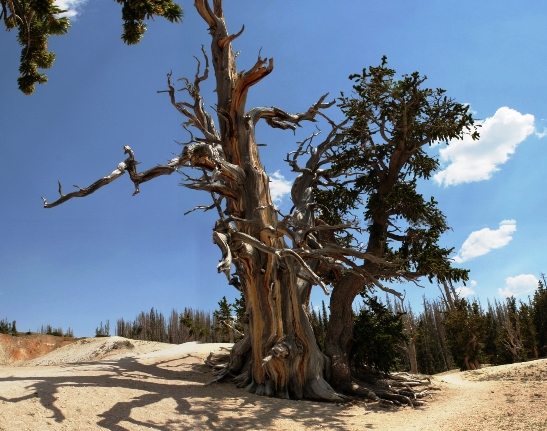Many trees enjoy extremely long lives in comparison to humans and other animals. Yet one group of trees, the bristlecone pines, stands out as the most ancient of all, with individual trees that commonly live for thousands of years, including one that has survived more than 5000 years. See also: Tree
Bristlecone pines are small- to medium-sized, slow-growing, long-living evergreen trees belonging to the genus Pinus (order Pinales, division Pinophyta). They belong to three species: the Great Basin bristlecone pine (P. longaeva), which lives to be especially old; the foxtail pine (P. balfouriana), which is rarer and has a "near-threatened" conservation status; and the Rocky Mountains bristlecone pine (P. aristata), which is the most populous. Typically gnarly and stunted in appearance, bristlecone pines are found at high altitudes in the western United States (including Arizona, California, Colorado, New Mexico, Nevada, and Utah), where they have adapted to harsh environments. They can grow in rocky soils with little rainfall and can withstand extreme seasonal temperature fluctuations. The bristlecone pine tree has dense branches with rust-brown bark, short needles in bunches of five, and thorn-tipped cone scales. See also: Dendrology; Pine

The extraordinary durability of the dense wood of bristlecone pines, which makes them remarkably resistant to pests, insects, and rot, is one of the keys to their incredible longevity. Bristlecone pines can grow during years when conditions are favorable, but then almost completely halt their growth during years when conditions are adverse. That slow growth process allows the wood of the trees to build in density, thereby preserving and sustaining the inner living vascular systems. Bristlecone pines also have adapted in various ways to the threats from periodic drought and near-drought, which they inevitably face during their long lives. These adaptations include a shallow, highly branched root system and waxy, thick needles that provide extra water retention. See also: Adaptation (biology); Drought; Plant tissue systems; Plant-water relations; Tree growth; Wood anatomy; Wood properties
In 2016, with the help of dendrochronological measurements and radiocarbon dating methods, scientists identified a specimen of Great Basin bristlecone pine that has been growing in the White Mountains in California for slightly more than 5000 years. (The location of the tree has been kept secret to protect it.) Other Great Basin bristlecone pine trees have been assigned ages of 4000–5000 years. The other species of bristlecone pines do not seem to live as long, although some of them have reached ages of 2000–3000 years as well. Because of their remarkable age, bristlecone pines are extremely useful to climate scientists, who can analyze the widths of the annual growth rings in the trees for use in their paleoclimate reconstructions. See also: Dendrochronology; Paleoclimatology; Radiocarbon dating
The Great Basin bristlecone pine tree that has lived for more than 5000 years qualifies as the most ancient known living nonclonal organism on the planet. Some types of trees that grow as clonal colonies can reach far greater ages: for example, a poplar forest of quaking aspens in Fishlake National Forest in Utah known as the Pando (or trembling giant) is estimated to be 80,000 years old. The 40,000 trees in that forest are genetically identical clones that share a root system. No individual trees within the aspen forest survive to great age, however, which is why comparisons of the ages of clonal colonies and nonclonal individuals are generally considered invalid. See also: Cloning; Poplar; Root (botany)





